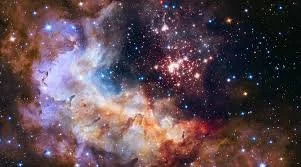The Void’s Finale: The End of the Universe
/Welcome to The Edge of the Void! Your booth is ready. Our waiting staff is at your beck and call. Your dining experience is one that’s been billions of years in the making.
What’s this reservation for? Dinner and a show. Your appetizer: Big Bang Spread on Rye. Your main course: Sizzling Entropy Roast. Your dessert: Dark Energy Soufflé.
And your entertainment tonight? Front-row seats to the end of the universe.
You’re probably asking yourself what half these things are. As your maître d’, I’ll give you the rundown.
Defining entropy, courtesy of Chemistrylearner.com.
This dining experience is the perfect lead-up to the end of the universe. Our appetizer begins our meal as its namesake began the universe, and I’m not talking about the rye. The big bang sent all matter and energy in the universe careening outwards from a dense, super-heated point about 13 billion years ago. It’ll be an explosion for your taste buds, assuredly.
Meanwhile, entropy continued to build as the universe spread out, making it a naturally abundant choice for our main course. Not sure what entropy is or if you might be allergic to it? Thankfully, you’d know if you were, since every chemical reaction, matter’s every change in state, and every movement in a system increases its entropy. Entropy is a measure of disorder, meaning that we’re moving closer to a more chaotic universe every moment. Your show tonight will make it clear how important that is. But for now, dig in! Dessert is on its way.
Our dessert comes with a side dish: the revelation that the expansion of the universe is accelerating. Why is this? That’s where the dark energy in our soufflé comes in. Much like how a typical soufflé rises, our dark energy soufflé will continue to rise and expand until it reaches unfathomable proportions. But what is dark energy? Is it some sort of exotic substitution for the classic soufflé recipe?
A ring of dark energy (superimposed in blue), courtesy of NASA and ESA.
Not quite. In fact, dark energy takes up about 68% of the universe, though we know more about what it isn’t than what it is. Our best guess is it’s akin to a constant energy fluid or field that fills all empty space. More importantly, the amount of dark energy seems to be growing. Its increasing density is pushing the universe apart faster and faster.
But, with dessert finished, tonight’s show is upon you! What will you see when we draw back the curtains? Even our fine establishment doesn’t know, but astrophysicists have three theories.
The first possibility is the universe’s heat death. Remember entropy? As the universe continues to expand, there will be a point where we reach maximum entropy and all energy will become forms that can’t carry out essential processes for existence. The universe will be left a disordered husk that has no potential for anything new. While our universe began with a heated bang, this would be the chilled whimper that ends it.
A second, more exciting possibility plays on our universe’s accelerating expansion: the big rip. Dark matter will continue to push apart the universe ever faster. Soon, galactic clusters, galaxies, star systems, stars, planets, and eventually atoms will be ripped apart as the force of expansion overcomes the forces binding them together. With atoms splitting in the last millionths of a second of existence, you’ll get to see a cascading series of nuclear explosions as the epic finale.
A graph for Potential paths for the end of the universe, courtesy of NASA and GSFC.
But what about the opposite effect? The universe’s expansion could decelerate and begin contracting towards its centre. This is the big crunch and may occur as gravity overcomes dark energy’s expansive force. Our universe will get crowded as galaxies, stars, and planets begin to collide. Increasing density will lead to skyrocketing temperatures as everything packs together before condensing to a dense, super-heated point. Sound familiar? Yes, this is the inverse of the big bang, where everything began. A fitting way to bookend the history of the universe.
However the end comes to pass, I hope you enjoy the show! We’ve been waiting between 22–200 billion years for you to arrive, but your reservation is ready, the food is good, and it’s an exclusive show. I don’t have a ticket, so do me a favour and tell me how it ends. I don’t mind spoilers.
Shawn Brixi — I’m an avid fan and writer of science fiction and fantasy. From the Alien to Star Trek, I’ve always been a fan of any media taking place in space and of the science of space and stellar exploration as a whole! I even built a model of the Hubble Telescope back in Grade 8 (before some goof broke it).
It’s my hope to eventually write a great book; whether it takes place in the cosmic void or another world entirely is anyone’s guess. In the meantime, I hope to entertain you all here on this blog!

































